| Origami Heaven A paperfolding
paradise
The website of
writer and paperfolding designer David Mitchell
x
|
| |
| Macromodular
Sculptures |
| |
| Macromodular
sculptures are second generation modular designs built by
combining complete modular assemblies into larger
structures either with, or without, the use of joining or
separating pieces. My macromodular sculptures are intended to
be partnership art, a concept that expresses
the partnership that often exists in origami/paperfolding
between the designer, who first conceptualises and
defines the design, and the folder, who realises one
expression of it at one particular point in time, so that
both contribute in equal partnership to the finished
work.
Many of these
designs are explained in my book Building with Butterflies.
Larger pictures of
many of these designs can be found in the Gallery of Macromodular
Sculpture.
All of the designs
on this page are abstract / geometrical except the
Macromodular Fox which is abstract / representational.
|
| |
| Towers |
| |
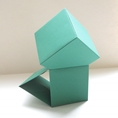 |
|
Name: The
Abstract Fox - a fox made using a Twin
Open Equilateral Triangular Prism for a body and
Paul Jackson's Cube for a head. Modules / Paper
shape / Folding geometry: All modules from
squares using standard folding geometry.
Designer /
Date: David Mitchell, 2020.
Reference:
573
Diagrams:
On-line diagrams are available on the Macromodular Designs page of this site.
|
|
| |
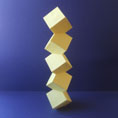 |
|
Name: The
Columbus Tower, also known as the Columbus
Cubes or Tower of Columbus Cubes,
is made by the simple expedient of
stacking Columbus Cubes one on top of the other.
Columbus Towers can be combined to form walls and
forests. Modules / Paper shape / Folding
geometry: Each Columbus Cube is made from 6
modules from squares using standard folding
geometry.
Designer /
Date: David Mitchell, 1989.
Reference:
043
Diagrams:
Mathematical Origami - Tarquin Publications -
ISBN 1-899618-18-X // In Portuguese - Origami
matematicos - Republicao - ISBN 972-570-257-3 //
Building with Butterflies - Water Trade - ISBN
0-9534774-1-X // Building with
Butterflies (2nd Edition) - Water Trade - ISBN
978-9534774-7-0 // On-line diagrams are available
on the Macromodular Designs page of this site.
|
|
| |
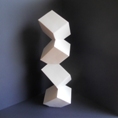 |
|
Name: The Tower
of Columbus Cuboids is made by stacking
Columbus Cuboids one on top of the other. Towers
of Columbus Cuboids can be combined to form walls
and forests. Modules / Paper shape / Folding
geometry: Each Columbus Cuboid is made from 6
modules folded from A4 or US Letter size sheets
of paper using standard folding geometry.
Designer /
Date: David Mitchell, 2015.
Reference:
374
Diagrams:
On-line diagrams are available on the Macromodular Designs page of this site.
|
|
| |
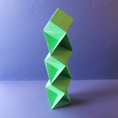 |
|
Name: The
Crooked Tower is made by combining Paul
Jackson Cubes and Robert Neale Octahedra
alternately in a stack Modules / Paper
shape / Folding geometry: Each Paul Jackson Cube
is made from 6 modules from squares using
standard folding geometry. Each Robert Neale
Octahedron is made from 6 modules from squares
using standard folding geometry.
Designer /
Date: David Mitchell, 1997.
Reference:
138
Diagrams:
Building with Butterflies - Water Trade - ISBN
0-9534774-1-X // Building with
Butterflies (2nd Edition) - Water Trade - ISBN
978-9534774-7-0
|
|
| |
 |
|
Name: Digitalis
- a macromodular sculpture made by
stacking Abstract Foxes. Modules / Paper
shape / Folding geometry: All modules from square
paper using standard folding geometry.
Designer /
Date: David Mitchell, 2020.
Reference:
573
Diagrams:
On-line diagrams are available on the Macromodular Designs page of this site.
|
|
| |
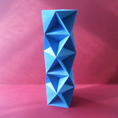 |
|
Name: Helterskelter
- a macromodular sculpture made by
stacking Gamma Antiprisms. Modules / Paper
shape / Folding geometry: Each Gamma Antiprism is
made from 8 squares using standard folding
geometry.
Designer /
Date: David Mitchell, 1999.
Reference:
179
Diagrams:
Photo only in Citizen K International magazine
Spring 99 // Building with Butterflies - Water
Trade - ISBN 0-9534774-1-X // Building with
Butterflies (2nd Edition) - Water Trade - ISBN
978-9534774-7-0.
|
|
| |
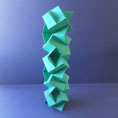 |
|
Name: The Icarus
Tower - a macromodular sculpture built
from Icarus Cubes using joining pieces. Modules / Paper
shape / Folding geometry: Each Icarus Cube is
made from 6 modules from squares using standard
folding geometry. Each joining piece is folded
from a one sixteenth size square using standard
folding geometry.
Designer /
Date: David Mitchell, 1998.
Reference:
161
Diagrams:
Building with Butterflies - Water Trade - ISBN
0-9534774-1-X // Building with
Butterflies (2nd Edition) - Water Trade - ISBN
978-9534774-7-0
|
|
| |
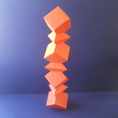 |
|
Name: The
Leaning Tower - a macromodular design
made by combining Paul Jackson Cubes and
Tricornes in a stack Modules / Paper
shape / Folding geometry: Each Paul Jackson Cube
is made from 6 modules from squares using
standard folding geometry. Each Tricorne is made
from 3 modules from squares using standard
folding geometry.
Designer /
Date: David Mitchell, 1998.
Reference:
167
Diagrams:
Building with Butterflies - Water Trade - ISBN
0-9534774-1-X // Building with
Butterflies (2nd Edition) - Water Trade - ISBN
978-9534774-7-0
|
|
| |
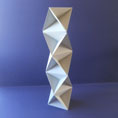 |
|
Name: The
Octahedral Tower - a macromodular design
made by stacking Robert Neale Octahedra with the
aid of joining pieces. Modules / Paper
shape / Folding geometry: Each Robert Neale
Octahedron is made from 6 modules from squares
using standard folding geometry. Each joining
piece is made from a square using standard
folding geometry.
Designer /
Date: David Mitchell, 1998.
Reference:
164
Diagrams:
Building with Butterflies - Water Trade - ISBN
0-9534774-1-X (as Tower of Octahedra) // Building with
Butterflies (2nd Edition) - Water Trade - ISBN
978-9534774-7-0
|
|
| |
.jpg) |
|
Name: Treesnake
- a macromodular design built from Diamond
Prisms. Modules / Paper shape / Folding
geometry: Each Diamond Prism is made from 8
modules from squares using standard folding
geometry.
Designer /
Date: David Mitchell, 1998.
Reference:
155
Diagrams:
Photo only in Citizen K International magazine
Spring 99 // Building with
Butterflies - Water Trade - ISBN 0-9534774-1-X
|
|
| |
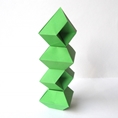 |
|
Name: Tower of Whatnots
- tower built from Whatnot macromodules Modules / Paper
shape / Folding geometry: Eavh Whatnot is made
from 2 modules from double bronze rectangles
using 60/30 degree folding geometry.
Designer /
Date: David Mitchell, 2016.
Reference:
582
Diagrams:
Not yet available.
|
|
| |
| Pyramids
and Tetrahedra |
| |
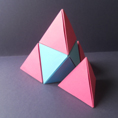 |
|
Name: 4
Regular Tetrahedra and a Regular Octahedron
combined to make a larger Regular Tetrahedron. Modules / Paper
shape / Folding geometry:
Designer /
Date: David Mitchell, 1997.
Reference:
Diagrams:
Mathematical Origami - Tarquin Publications -
ISBN 1-899618-18-X // In Portuguese - Origami
matematicos - Republicao - ISBN 972-570-257-3
|
|
| |
 |
|
Name: 4
Rhombic Pyramids combined to make a Rhombic
Tetrahedron Modules / Paper
shape / Folding geometry:
Designer /
Date: David Mitchell, 1997.
Reference:
147
Diagrams:
Mathematical Origami - Tarquin Publications -
ISBN 1-899618-18-X // In Portuguese - Origami
matematicos - Republicao - ISBN 972-570-257-3
|
|
| |
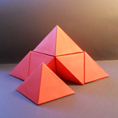 |
|
Name: 8
Rhombic Pyramids into a larger Rhombic Pyramid Modules / Paper
shape / Folding geometry: Rhombic Pyramids are
made from modules folded from silver rectangles.
Designer /
Date: David Mitchell, 2000
Reference:
147
Diagrams:
In Mathematical Origami (2nd Edition) -
David Mitchell - Tarquin publications - ISBN
9781911093169
|
|
| |
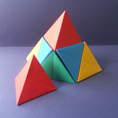 |
|
Name: 8
Rhombic Tetrahedra into a larger Rhombic
Tetrahedron. Modules / Paper
shape / Folding geometry: Rhombic Tetrahedra are
made from modules folded from silver rectangles.
Designer /
Date: David Mitchell, 1996
Reference:
129
Diagrams:
Mathematical Origami - Tarquin Publications -
ISBN 1-899618-18-X // In Portuguese - Origami
matematicos - Republicao - ISBN 972-570-257-3
|
|
| |
 |
|
Name: Aleph
Pyramids - macromodular sculptures built
from Aleph Prisms. Modules / Paper shape / Folding
geometry: Each Aleph Prism is made from 3 modules
from squares using standard folding geometry.
Designer /
Date: David Mitchell, 2005.
Reference:
270
Diagrams:
Diagrams not yet available.
|
|
| |
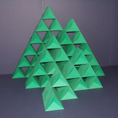 |
|
Name: Alpha
Pyramids - macromodular sculptures built
from Alpha Prisms using joining pieces. Modules / Paper
shape / Folding geometry: Each Alpha Prism is
made from 6 modules from squares using standard
folding geometry.
Designer /
Date: David Mitchell, 1997.
Reference:
135
Diagrams:
Photo only in Citizen K International magazine
Spring 99 // Building with Butterflies - Water
Trade - ISBN 0-9534774-1-X // Building with
Butterflies (2nd Edition) - Water Trade - ISBN
978-9534774-7-0
|
|
| |
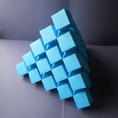 |
|
Name: Columbus Cubes
can be combined with separating pieces to produce
the Columbus Pyramid shown here. Modules / Paper
shape / Folding geometry: Each Columbus Cube is
made from 6 modules from squares using standard
folding geometry. Each joining piece is from a
square using standard folding geometry.
Designer /
Date: David Mitchell, 1997.
Reference:
137
Diagrams:
Building with Butterflies - Water Trade - ISBN
0-9534774-1-X // Building with
Butterflies (2nd Edition) - Water Trade - ISBN
978-9534774-7-0
|
|
| |
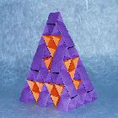 |
|
Name: Damocles
- a macromodular design made by combining Alpha
and Beta Prisms. Modules / Paper shape / Folding
geometry: Each Alpha Prism and each Beta Prism is
made from 6 modules from squares using standard
folding geometry.
Designer /
Date: David Mitchell, 1997.
Reference:
136
Diagrams:
First published without the orange inserts as
Tower of Babel in Building with Butterflies -
Water Trade - ISBN 0-9534774-1-X // As Damocles
with inserts in Building with
Butterflies (2nd Edition) - Water Trade -
ISBN 978-9534774-7-0.
|
|
| |
 |
|
Name: Elite
Pyramid - Macromodular design made from
Elites stacked using joining pieces. Modules / Paper
shape / Folding geometry: Each Alpha Prism and
each Beta Prism is made from 6 modules from
squares using standard folding geometry.
Designer /
Date: David Mitchell, 1991.
Reference:
076
Diagrams:
Building with Butterflies (1st Edition) - Water
Trade - ISBN 0-9534774-1-X
|
|
| |
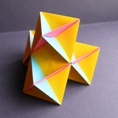 |
|
Name: Four
Octahedra - four Robert Neale Octahedra
linked with joining pieces from squares in such a
way that it appears to be made of six
intersecting planes. Designs with more linked
ocahedra are possible. Modules / Paper
shape / Folding geometry: Each Robert Neale
Octahedron is made from 6 modules from squares
using standard folding geometry. Each joining
piece is from a square using standard folding
geometry.
Designer /
Date: David Mitchell, 2016. Update of work from
1995.
Reference:
164
Diagrams:
In Building with Butterflies - David Mitchell -
Water Trade - ISBN 978-0-9534774-7-0.
|
|
| |
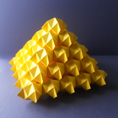 |
|
Name: Mothership
- design made using Paulo Mulatinho's
UFO as a macro-module - from squares. Modules / Paper
shape / Folding geometry: Each UFO is made from 2
modules from squares using standard folding
geometry.
Designer /
Date: David Mitchell, 2001.
Reference:
265
Diagrams:
Not yet avaiable.
|
|
| |
 |
|
Name: The
Octahedral Pyramid - single colour
version - a macronodular design made using Robert
Neale Octaahedra as macromodules and linked by
joining pieces. Modules / Paper shape / Folding
geometry: Each Robert Neale Octahedron is made
from 6 modules from squares using standard
folding geometry.
Designer /
Date: David Mitchell, 1998.
Reference:
164
Diagrams:
Building with Butterflies - Water Trade - ISBN
0-9534774-1-X // Material and Immaterial: Paper
Art in Israel - Exhibition Catalogue - 2008 // Building with
Butterflies (2nd Edition) - Water Trade - ISBN
978-9534774-7-0
|
|
| |
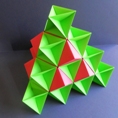 |
|
Name: The
Octacube Pyramid - made by combining
Paul Jackson Cubes and Robert Neale Octahedra. Modules / Paper
shape / Folding geometry: Each Paul Jackson Cube
is made from 6 modules from squares using
standard folding geometry. Each Robert Neale
Octahedron is made from 6 modules from squares
using standard folding geometry.
Designer /
Date: David Mitchell, 1997.
Reference:
Diagrams:
Not yet available.
|
|
| |
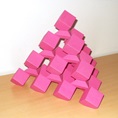 |
|
Name: Slide
- made by combining Columbus Cubes, Paul Jackson
Cubes and truncated hexahedra macromodules in a
pyramidal form. The cubes and truncated hexahedra
are linked together with joining pieces. Modules / Paper
shape / Folding geometry: Each Paul Jackson Cube
and each Columbus Cube is made from 6 modules
from squares using standard folding geometry.
Each truncated hexahedron is made from 3 modules
from squares using standard folding geometry.
Designer /
Date: David Mitchell, 2010.
Reference:
167
Diagrams: Building with
Butterflies (2nd Edition) - Water Trade - ISBN
978-9534774-7-0. These diagrams incorrectly show
to use Tricorne macromodules rather than Mark Two
macromodules / Corrected diagrams are now
available on the Macromodular Designs page of this site.
|
|
| |
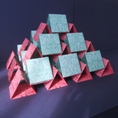 |
|
Name: Temple
of the Winds - a macromodular design
made from triangular prisms and
joining/supporting pieces. Modules / Paper
shape / Folding geometry: Each prism is made from
2 squares using standard folding geometry. Each
joining piece is made from a square using
standard folding geometry.
Designer /
Date: David Mitchell, 2014.
Reference:
370
Diagrams:
Not yet available.
|
|
| |
| |
|
Name: Three-quarter Cube
Sierpinski Pyramid Modules / Paper
shape / Folding geometry: Modules from squares
using standard folding geometry.
Designer /
Date: Macromodules David Mitchell, 2016.
Sierpinski Pyramid concept by Kumars Sharif.
Reference:
373
Diagrams:
On-line diagrams are available on the Macromodular Designs page of this site.
|
|
| |
| Rings |
| |
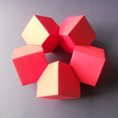 |
|
Name: Ring
of Cubes. The unmathematical geometry of
the design was analysed in passing by Jeannine
Mosely in an article in Origami3 - A K Peters Ltd
- ISBN 1568811810 entitled 'The Validity of the
Orb, An Origami Model'. A drawing of the design
features on the cover artwork. Version 1: made
by glueing five Columbus Cubes together
Modules /
Paper shape / Folding geometry: 30 modules from
squares using standard folding geometry.
Designer /
Date: David Mitchell, 1990 (both versions).
Reference:
043
Diagrams:
Mathematical Origami - Tarquin Publications -
ISBN 1-899618-18-X // In Portuguese - Origami
matematicos - Republicao - ISBN 972-570-257-3
Version
2: made by linking together five Ring of
Cubes macromodules, which are provided with the
necessary tabs and pockets to make this possible
without needing to use glue.
Modules /
Paper shape / Folding geometry: 30 modules from
squares using standard folding geometry.
Reference:
057
Diagrams: Building with
Butterflies (2nd Edition) - Water Trade - ISBN
978-9534774-7-0
|
|
| |
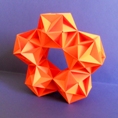 |
|
Name: Ring
of Elite 1s - 5 Elite 1s linked by
joining pieces. A ball of 20 Elite 1s is also
possible. Modules / Paper shape / Folding
geometry: All modules from silver rectangles.
Designer /
Date: David Mitchell, 1993.
Reference:
076
Diagrams:
Not yet available.
|
|
| |
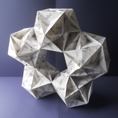 |
|
Name: Ring
of Elite 2s - 5 Elite 2s linked by
joining pieces. A ball of 20 Elite 2s is also
possible. Modules / Paper shape / Folding
geometry: All modules from silver rectangles.
Designer /
Date: David Mitchell, 1993.
Reference:
076
Diagrams:
Not yet available.
|
|
| |
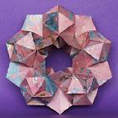 |
|
Name: Stargate
- 5 Artifacts linked by joining pieces. Modules / Paper
shape / Folding geometry: All modules from silver
rectangles using silver rectangle folding
geometry.
Designer /
Date: David Mitchell, 1995.
Reference:
056
Diagrams:
In Complete Origami - Collins and Brown - David
Mitchell - ISBN 978-1-84340-397-5 // On-line
diagrams are available on the Diagrams: On-line
diagrams are available on the Macromodular Designs page of this site.
|
|
| |
| Balls |
| |
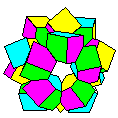 |
|
Name: Ball
of Cubes. 20 cubes arranged at the
vertices of a dodecahedron. Further macromodules
can be added to produce more complex forms. Version 1:
Glued
Modules /
Paper shape / Folding geometry: 120 modules from
squares using standard folding geometry.
Designer /
Date: David Mitchell, 1990
Reference:
043
Diagrams:
Mathematical Origami - Tarquin Publications -
ISBN 1-899618-18-X // In Portuguese - Origami
matematicos - Republicao - ISBN 972-570-257-3 //
Discussed in Compound Platonic Polyhedra in
Origami - Lengvarszky, Zsolt - Mathematics
Magazine - Volume 79, Number 3, June 2006 , pp.
190-198(9)
Version
2: Pure origami
Modules /
Paper shape / Folding geometry: 120 modules from
squares using standard folding geometry.
Designer /
Date: David Mitchell, 1990
Reference:
057
Diagrams:
BOM 146 February 1991 // Building with
Butterflies (2nd Edition) - Water Trade - ISBN
978-9534774-7-0
|
|
| |
 |
|
Name: Nexus -
20 Artifacts linked by joining pieces. Modules / Paper
shape / Folding geometry: All modules from silver
rectangles.
Designer /
Date: David Mitchell, 1995.
Reference:
056
Diagrams:
// May 22nd photo in Origami 2006 Calendar -
Andrews McMeel - ISBN 0-7407-5195-6 // On-line
diagrams are available on the Modular and
Macromodular Designs page of this site.
|
|
| |
| Lattices |
| |
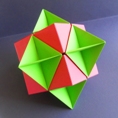 |
|
Name: The
Octacube is made by combining eight Paul
Jackson Cubes and six Robert Neale Octahedra.
Larger versions can be constructed by adding more
macromodules. Modules / Paper shape / Folding
geometry: Each Paul Jackson Cube is made from 6
modules from squares using standard folding
geometry. Each Robert Neale Octahedron is made
from 6 modules from squares using standard
folding geometry.
Designer /
Date: David Mitchell, 1997.
Reference:
Diagrams:
Not yet available.
|
|
| |
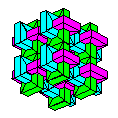 |
|
Name: Borromean
Lattice - lattice made by combining
Borromean Links designs using simple joining
pieces. Modules / Paper shape / Folding
geometry: All modules from squares using standard
folding geometry.
Designer /
Date: David Mitchell, 1999.
Reference:
058
Diagrams:
Not yet available.
|
|
| |
 |
|
Name: The
Elite Hypercube - made by combining 20
Elite 1 macromodules using joining pieces. In
theory it would also be possible to build this
structure using Elite 2 macromodules. Modules / Paper
shape / Folding geometry: All modules and joining
pieces folded from silver rectangles.
Designer /
Date: David Mitchell, 1991.
Reference:
076
Diagrams:
Building with Butterflies (1st Edition) - Water
Trade - ISBN 0-9534774-1-X // On-line diagrams
are available on the Diagrams: On-line diagrams
are available on the Macromodular Designs page of this site.
|
|
| |
| |







.jpg)






















